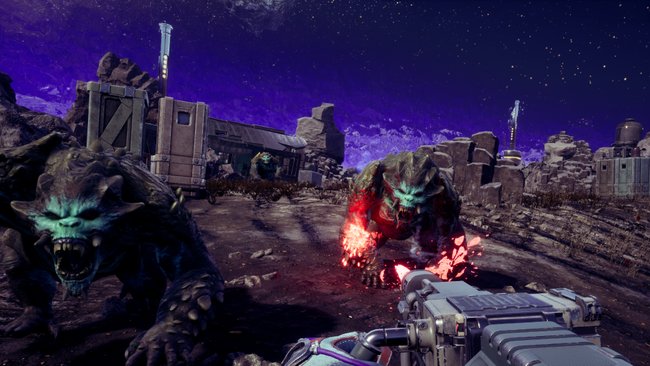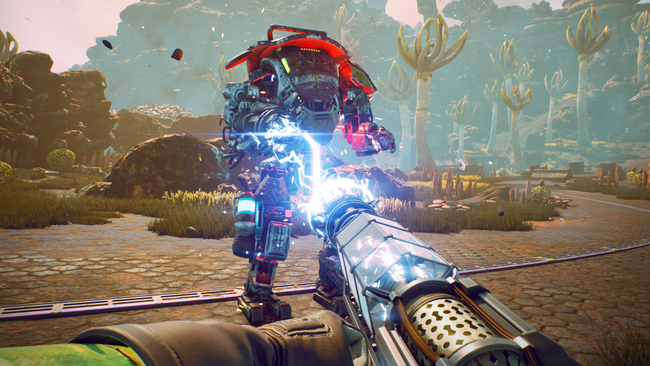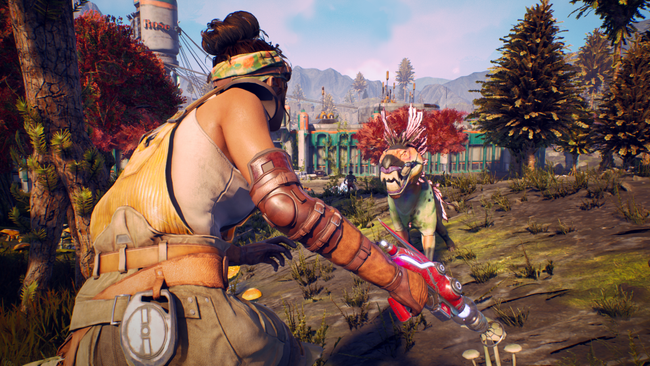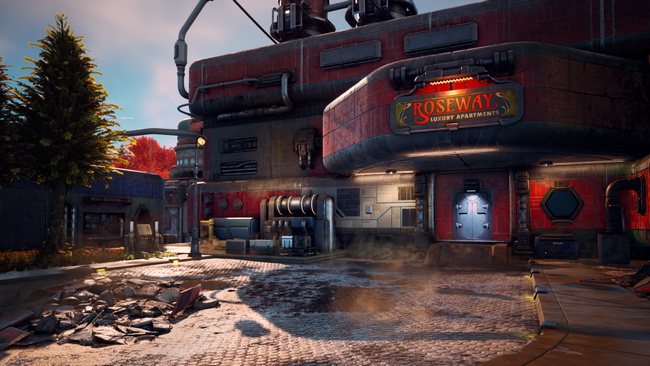
The Outer Worlds Interview: A Chat With Lead Designer Charles Staples
We recently had the opportunity to attend a preview event for Obsidian Entertainment's upcoming The Outer Worlds, where we had the chance to play through several hours of the game. We've got a hands-on impressions piece you can check out, but we also took the time to sit down with the title's Lead Designer, Charles Staples, to talk about all the little things that are going into making The Outer Worlds tick.
RPG Site: The Outer Worlds – I guess I’ll just start with what everyone’s thinking. It seems to take a lot of inspiration from your previous work on Fallout: New Vegas, albeit with some pretty unique differences. Can you explain the thought process behind balancing the old and the new?
Charles Staples: That is the basic idea with what we’ve been doing – so with this new IP, and this new game, we’re trying to leverage a lot of what we’ve learned before – and with Tim and Leonard being the game directors on the project, using a lot of their experiences and expertise in crafting worlds and the setting – and then, just trying to make sure, as an RPG, a modern RPG, how can we take a lot of the classic RPG elements that people love, and how can we put them in a modern setting? A lot of that is – I worked on Fallout: New Vegas, and there’s a lot of lessons that we learned on that project, and how can we learn from the previous games that Obsidian has made, how can we incorporate those into this one? There’s been a lot of effort put into how we write, how we do characters, the choice and consequence, what we’ve learned about complexity – and using that as a basis for making this game.

RPG Site: I think the words “Choice and Consequence” definitely stands out to me, coming off of this preview session – especially regarding the perk and the flaw system. I know that not everyone that played through this preview today actually came across it, but I noticed it a few times where – it would say something like “hey, you’re afraid of bugs now – do you want to accept this flaw and get a free perk point, but lose damage against bugs” or something like that. It was really interesting, because when you look at the perks in the game – and I’m sure they’re still being worked on, but still – most of them seem pretty substantial in their benefit to the player. It seems like an interesting, as you said “choice and consequence”, giving the players the ability to take this flaw unto themselves while bolstering your abilities in another way as a trade-off. It’s a very unique mechanic—what’s the idea behind that?
Staples: So, Tim Kane has had this idea for a very long time – it’s a way to have, well, flawed heroes are way more interesting than having a god reigning over everything, and this was a way to add that in there, and also—instead of just having whatever character you create at the beginning of the game, be the one you use moving forward—having it dynamically change over the course of the game is like, “because of my experiences, and because of what’s happening to my character, this is how my character can change—and it can change how I’m roleplaying my character”. So this is an idea that Tim’s had for a while, and he’s wanted to put into to an RPG to see how it works.
RPG Site: I noticed that the hardest difficulty – Supernova? - might be forcing you to take on these flaws if they appeared. Can you explain the idea that went into that?
Staples: I’m not completely sure if we’re planning to actually force players to use these flaws on Supernova, but we will be changing the number of flaws that you can take depending on the difficulty. So, 3 on Story Mode and Normal Difficulty, 4 on Hard, and 5 on Supernova. But we did realize that some players might not want to take the penalty no matter what the bonus was – so that’s why we decided that we wanted it to be an opt-in experience, so like they can decide either “Hey, this sounds interesting and I want to experience it” or “Nah, this doesn’t seem right for me”.

RPG Site: I see – I think it would be interesting to have an option on save file creation to force players to take any flaws that appear. But I guess going from there—choice and consequence. I’m gonna stick on that because I feel like it really resonates with a lot of thoughts I’m having about the game. I noticed that a lot of the sidequests, a lot of them you really had to go out of your way to find, definitely had multiple ways for clearing them. Like, there was this C&P Factory sidequest where—like, they tell you that you could outright go in guns blazing and kill a guy, or you can go in the back way through the sewer, or sneak in using a false ID card. Then you can do something like poisoning pigs, messing with the machinery, falsifying records, or so on. I found it impressive just how much freedom I had with sidequests, not just this one, for how I wanted to finish them. Is that something that players can expect to see throughout the rest of the game?
Staples: That’s been a big focus for us. We wanted to make sure that the sidequests weren’t just throwaway fetch quests, we wanted to make sure that they all had an interesting narrative and characters that reinforced the setting and the world. Making sure you have choices along the way, and how the choices that you make have different outcomes—for example, in the sidequest you were talking about, there’s also the option to betray the original quest-giver too. That is just part of the—roleplaying the character that you want to do, and allowing you to have all the options and seeing what can happen based off of those decisions. I think that Tim is on his tenth or eleventh playthrough of the game? And, and he does a different build and playstyle each time, and there are still new things that he’s discovering. Stuff like “I did it this way this time, and because I did this, this other thing happened”. It’s a lot of work, but we made sure—that we started with “how does a combat character get through this, how does a stealth character get through this, how does a dialog character get through this?” and then once we got those basics, we go through like, well, how does a player that chose engineering or these other skills feel rewarded? How do we make them feel “hey, because I made this specific character, I get to do these things?” That’s been a big focus for us.
RPG Site: So are there unique rewards for doing it specific ways, for each type of character? Or is it just different ways to clear quests, and not specifically unique rewards?
Staples: Some quests can be completed certain ways that will give you different rewards, yes, but it’s not on every quest. So sometimes it’ll just be – this person wanted X done, there’s 3 ways to do it, but as long as it gets done – they’re happy. But there are also quests where it’s like—this person wanted this, this other person wanted the same thing, and you either help one or the other. Or, this person wants you to get something, but then you gave it to someone else. So there are all sorts of different permutations that can happen.

RPG Site: One thing I do want to ask about is the companion characters. Now, obviously Obsidian’s games have had companions in the past, but it stood out to me just how fleshed out—even in just the small preview session I had—these companion characters felt like. Like, Nyoka, in the beginning of the second session, I spoke with her and it led me on this long sidequest about helping her make amends with her fallen comrades, that went on long enough that I couldn’t progress through the rest of it do to demo limitations. Both her and Pavarti have these interesting things to say about what you’re doing, where you are—most of the times in games, and even RPGs, you’ll have dialog that your party members will say in the moment, but it really stood out to me just how natural some of these dialogs felt. Like Pavarti even saying, when I was at this radio tower for a sidequest, saying something like “I wonder how they managed to punch the radio signal outside of the gas giant’s atmosphere”. What went into designing those partner characters?
Staples: So a lot of that has been, taking what we’ve learned from previous games, and one of the big efforts that Leonard wanted to see on this one was—how can we have our companions be more involved with the story, and the game, and interacting with everything, a little bit more? So our narrative team has done a lot of work on making sure that we have fleshed-out characters, and understanding like—this is what this character likes, and what they know. How would they react to all these different situations in the world? What about this quest, or this one, or reaching this location? So the narrative team would have a detailed write-up of the character, and all the things they’re interested in, and so while we’re making the game we’ll make sure—well, they’d be talking with this guy about this person, and on this quest they should be interjecting here since they know something. Giving additional depth to our companion characters was something that we really wanted to focus on.
RPG Site: And that’s all optional too—because you can choose to not take on any companions, right?
Staples: Yes, yes you can. And depending on what you do, you might miss companions—if you’re just focused on the main quest, some of them might not show up—and depending on what choices you make, you might pick up a companion that doesn’t like some of what you’re doing, and they decide to leave your party. We wanted to have them feel like believable characters and people, and I feel like our narrative team has done an excellent job with that.

RPG Site: Speaking of narrative – though maybe that isn’t the right word for it. I definitely noticed that a lot of dialog in the game, both from other characters and NPCs, was very… is flowery the right word for it? There’s definitely a lot of personality behind the dialog. Do you know anything about what went into that? I guess did you have anything to do with that?
Staples: I didn’t, but Leonard did. Leonard has put a lot of work into figuring out how our characters should talk, how we get these sort of frontier, space style dialog. There’s a lot—we have a few reference points for how characters should talk. I think some of the stuff in True Grit, and some of the Cohen Brothers movies on how people talk, was an insolence on how we wrote our characters.
RPG Site: I definitely appreciated what I read—I feel like you guys balanced that wit, without it feeling forced. They’re were witty, but not in the “I need to make a quip here”, but rather how a person would actually react.
Staples: I think that’s our narrative team—we focus a lot on characters, and dialog, and I think our narrative team has done an excellent job.
RPG Site: So talking about combat: I feel like one of the stereotypes about Fallout: New Vegas was, the game itself is great, but the combat felt a bit limiting. With The Outer Worlds, I’ve definitely noticed that there has been some more care was put into how the combat flows. So you have the Time Dilation mechanic, where you can slow down things, and you also have partner actions—and you can even sidestep an enemies attack, dodging them. It feels like there’s been more of a focus—and the gunplay is feeling a lot better too—put into trying to improve the combat, as well as the rest of the game. Can you talk about what went into that?
Staples: So some of it was—at Obsidian we’ve noticed feedback of “hey, sometimes the game mechanics get in the way of the story you’re trying to tell”, so that was a big focus for us. So we took a hard look at what was the core combat of the game, how can we make sure that experience meets expectations, and it isn’t getting in the way of everything else—so people don’t feel like they just have to put up with it progress the story. So we spent a lot of time, since we have shooting as one of the core mechanics, we took a lot of time looking at how the gunplay, our feedback, how our main AI works, and making sure it felt as good as possible. Of course we did the same with our melee as well. Then, since the game is an RPG first and foremost, we wanted to make sure the game has a wide variety of tools—but not everyone is going to want to use all of them. Some players aren’t going to want to dodge, some aren’t going to want to melee. Some players are going to use the companion abilities, while others might not want to. So in typical RPG fashion—give the player a toolbox, make sure that these tools have a good purpose and a good fit in the game, and they feel good on their own, and then have that all come together for people that will want to use them.

RPG Site: I noticed that, comparing the first session and the second session, there was a very obvious difference in the locales between the first planet and the second planet in the preview sessions. I know there’s even more environments than that—but what’s the sort of philosophy that goes into how each planet has its own identity?
Staples: So we have two main planets that were colonized in the system—the first being “Terra-2”, the one that has been Terra-formed appropriately. That’s the one that looks sorta Earth-like, there’s some similar feeling, and that’s the one that has a lot of the civilizations and communities. Then there’s the other one, Monarch, the sort of one that wasn’t Terra-formed correctly. That’s sort of now the “monster plant”, where the indigenous life has sort of morphed, mutated, grown larger and ferocious. It’s not a fun, friendly place to be. Then we’ve had other locations in the game as well—space stations, asteroids, that you get to explore. A lot of it was trying to—how do we do that Sci-fi wish-fulfillment, of getting to explore new locations, and having it feel like a space exploration and Sci-fi game.
RPG Site: Is there anything else you want to tell players—I guess highlight about the game?
Staples: I think the big thing for us is, we’re trying to make the type of RPG that RPG fans are looking for. This is the type of game that we love to make. We love having interesting stories, and interesting characters, and allowing you to interact with them the way that you want to. This is a game where we’re using a lot of what we’ve learned from previous games, and trying to make something that we think fans of RPGs will like—but also make it accessible to people that may not be into RPGs that much, but might want to give it a chance as well.